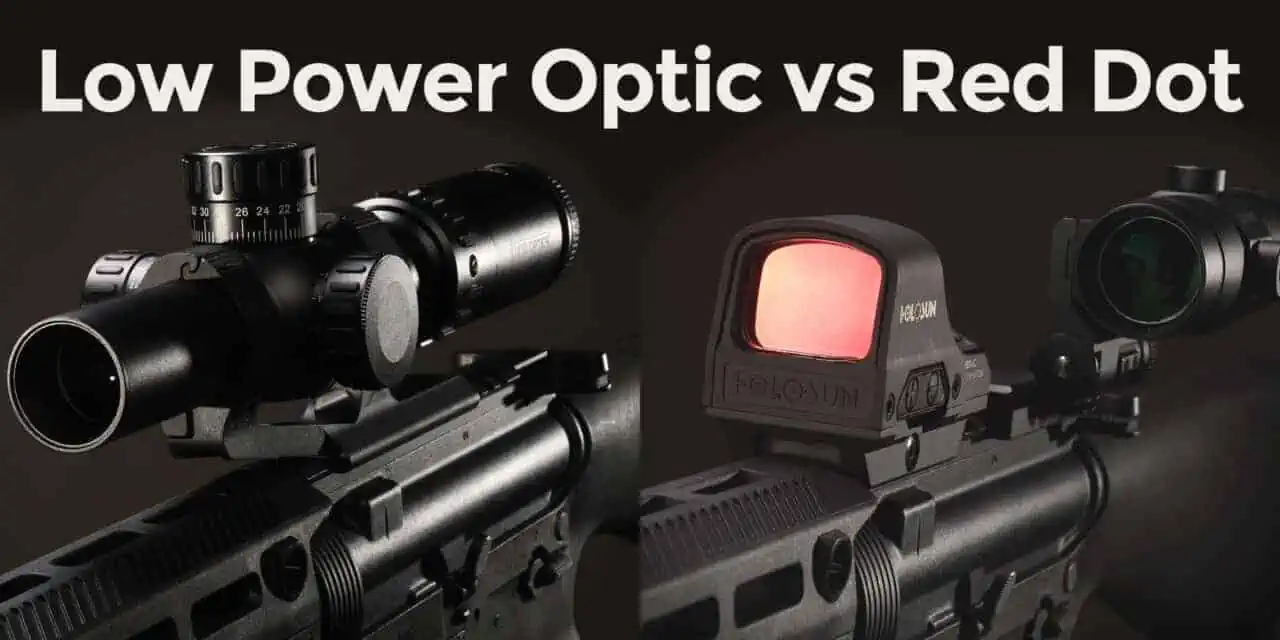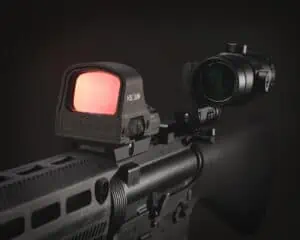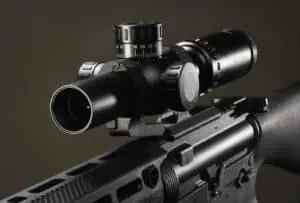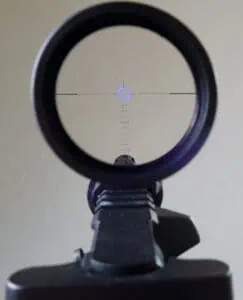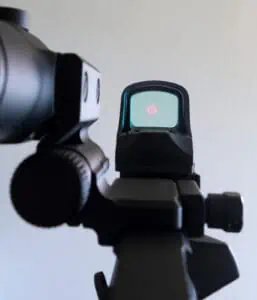In Focus: LPVO vs Red Dot Sights
In the beginning, there was the iron sight. And it was good. Whether it was adjustable or non-adjustable, peep or buckhorn, open or aperture, iron sights were pretty much the only sighting system available for hundreds of years. However, the introduction of the brass cartridge made it possible to predict the path of the bullet out to hundreds of yards. Improved manufacturing processes meant that we could make glass clear and precise enough to build small telescopes that would fit on the top of a rifle.
Telescopic sights became more and more popular for long-range shooting. In the mid-80’s, however, Aimpoint introduced the red dot sight. They designed it for fast target acquisition at short distances. EOTech rolled out the first holographic sight in the mid-90’s, which uses a process very similar to a red dot optic. At about that same time, Schmidt & Bender created the first practical low power variable optic, or LPVO. We’ll take a look at holographic sights in a later article but right now, let’s compare the LPVO vs a red dot optic and see how they stack up when used on the AR-15 platform.
LPVO vs Red Dot Fast facts
- Holographic sights and red dots both use laser projection to create an aiming point
- Most red dots and holographic sights need batteries to work, LPVOs work just fine without them
- LPVOs can range from 1x to 4x, 6x and even up to 10x, while red dots are 1x power and require a separate magnifier
What A Red Dot Does
Lightweight and compact, a red dot sight doesn’t take up a lot of room on top of your rifle. The red dot optic we used in our test weighs just 8 ounces. That’s one-third the weight of an LPVO with a mount. Even with an additional magnifier to increase utility at longer distances, the sight we chose weighed 19 ounces compared to the 24.5 ounces of an LPVO.
Speaking of long distances, a red dot is, by its very nature, a 1x optic. This means that additional magnification might come in handy for shots beyond 100 yards. However, it also means that a red dot will have almost limitless eye relief compared with an LPVO. How does that impact you as a shooter? With a red dot, you can make effective shots with a less-than-perfect check weld on your rifle stock.
However, a red dot does have some downsides. The first (and most obvious) is that it requires a battery to power the reticle. No power, no shot. This can be overcome with things like solar powered backups and “instant on” technology for longer battery life, but at some point, you’ll need to swap out your battery if you want to make the shot. A red dot is also almost completely based on electronic components, which can fail at inopportune moments. However, I’ve found that any misure or damage that would knock a red dot out of commission is usually also strong enough to put a conventional optic out of commission. So, let’s call that even. Speaking of conventional optics…
Advantages Of An LPVO
A low power variable optic gives you a familiar optic on top of your rifle. Anyone who’s shot a scope of any kind will immediately grasp what an LPVO does and how you should use it. The maximum magnification of an LPVO is much higher than a red dot. This means you can zoom out to 4x, 6x or even 10x to make sure you get the shot at 300 yards and beyond.
An LPVO is also easy to set up and use. There are no additional magnifiers needed for long-range shots, and the reticle will be there even if your batteries fail. However, the optics inside an LPVO means the eye relief can be much shorter than an LPVO. This in turn requires you to pay more attention to your cheek weld and eye position, especially at higher magnifications.
Things are a bit different when it comes to field of view, or how much you can see left or right, up or down in your scope. The field of view is typically wider in an LPVO vs a red dot. However, LPVOs are mounted closer to your eye, which forces you to block out your non-dominant eye and concentrate on what’s showing up inside your optic. This can make you feel like the LPVO has a narrower field of view, but in reality, the reverse is true.
Let’s Put Them To The Test
The optics we’ll be using in our LPVO vs red dot comparison both represent some of the latest generation of high-quality, budget friendly optics on the market today. The low power optic is a 1-6x second focal plane scope from Lucid Optics. We’ll paired it with an Aero Precision Lightweight cantilever mount. The scope has a reticle with MOA markings that allow you to estimate the range to your target when used at 6x, along with 11 levels of illumination for use in low light situations.
The red dot is actually a Holosun HS510C reflex sight that has a 2 MOA center dot and a 65 MOA outer ring. The dot gives you a precise aiming point, and the 65 MOA outer ring is handy in close quarters situations where “minute of bad guy” is all you need to get effective hits. This particular model of Holosun has two power sources for its reticle. The first is a CR2032 battery, the same battery used in the Lucid scope. The second power source is a small solar cell that recharges an internal battery, giving you a reticle when the primary power source is exhausted.
The Holosun sight, like other red dot / reflex sights, is a 1x optic. To help it perform better at longer ranges, we’re going to pair it with a VMX-3T 3x magnifier from Vortex Optics. The magnifier attaches to the rail behind the Holosun sight and swings in or out of view with the push of a button. In theory, this combination will give us similar performance from an LPVO vs a red dot optic.
Time to test that theory.
Comparing an LPVO vs a Red Dot
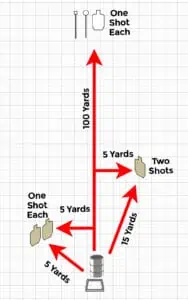 We created a short test in order to get an idea of how each optic performs against the other. There are six targets on the stage, which will require seven rounds of ammunition to shoot. The course of fire is as follows:
We created a short test in order to get an idea of how each optic performs against the other. There are six targets on the stage, which will require seven rounds of ammunition to shoot. The course of fire is as follows:
- Engage two USPSA cardboard targets at five yards with one shot each from low ready. This will test each optic’s ability to get on target quickly and how easy the optic is to use when transitioning from one target to another at close ranges
- Engage one USPSA cardboard target twice at fifteen yards. This will test how well each optic handles followup shots.
- Engage three steel targets at 100 yards with one shot each, from a rest. The targets are a full-size IPSC torso target, a 4 inch circular plate and a ¼ scale IPSC torso target. This will give us an idea of the performance of an LPVO vs a red dot at longer ranges.
The gun we’ll be using in our test is built on a CavArms polymer AR-15 with a 16 inch barrel, shooting PMC M193 55 grain FMJ ammunition. We’ll record each run with a shot timer and add a one second penalty for each hit outside of the A zone on the cardboard targets and five seconds for each miss.
Test Results
The results were a bit surprising. It took longer to engage the first target with an LPVO vs a red dot, which isn’t a surprise. What was surprising, however, was how effective the one-two combination of a reflex sight and magnifier was at 100 yards. There was one more miss on the first run with the red dot (I rushed things a bit) and without that extra penalty, the average time for an LVPO vs. a red dot would have effectively been identical.
| LPVO vs Red Dot | Red Dot 1 | LPVO #1 | Red Dot 2 | LPVO #2 | Red Dot 3 | LPVO #3 | Avg Red Dot | Avg LPVO |
|---|---|---|---|---|---|---|---|---|
| First Target | 1.06 | 1.13 | 1.04 | 1.25 | 1.11 | 1.19 | 1.07 | 1.19 |
| Second Target | 0.15 | 0.28 | 0.19 | 0.24 | 0.21 | 0.19 | 0.18 | 0.24 |
| Third Target Shot #1 | 1.03 | 1.09 | 1.17 | 1.14 | 1.16 | 1.09 | 1.12 | 1.11 |
| Third Target Shot #2 | 0.19 | 0.27 | 0.28 | 0.24 | 0.24 | 0.19 | 0.24 | 0.23 |
| 100yd Torso | 4.12 | 4.08 | 6.02 | 4.28 | 5.23 | 6.20 | 5.12 | 4.86 |
| 100yd head | 3.00 | 2.24 | 3.02 | 2.11 | 3.11 | 2.09 | 3.04 | 2.15 |
| 100yd 1/4 Torso | 2.14 | 3.10 | 2.21 | 4.17 | 3.07 | 2.17 | 2.47 | 3.15 |
| Penalties | 10 | 5 | 0 | 0 | 0 | 0 | 0 | 0 |
| Total Time (Seconds) | 21.69 | 17.19 | 13.93 | 13.40 | 14.13 | 13.14 | 16.58 | 14.59 |
Two adjustments to this test would have shifted the results one way or another, I believe. The first would be to engage targets out to 300 yards rather than just stay at 100 yards. It is much easier for me to deal with the different holdovers due to the 50 yard zero on my rifle at 200 or 300 yards using the reticle in an LPVO than it is to guess those distances using a red dot or a reflex sight.
By that same token, a course of fire that involved shooting around barricades or other confined spaces would favor a red dot sight. The more expansive eye box and wider apparent field of view with that type of optic makes for faster engagement times at short distances, something that is very important in a close quarters battle.
Which Should You Choose: LPVO vs Red Dot?
In the end, the choice of LPVO vs red dot comes down to your perceived need and how you intend to use your rifle. If you use a rifle for short to medium range hunting, or are interested in something like a scout rifle, then an LPVO makes a lot of sense.
However, if you use an AR-15 for home defense or hog hunting, then a red dot or reflex sight makes a lot of sense. Whatever optic you choose, remember that it’s the rifleman who makes the shot, not the rifle, so make sure you go out and get the training and practice you need to make the shot when it matters the most.

